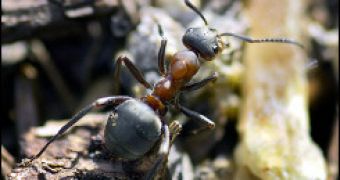We pride ourselves with our scientific discoveries, but we do nothing more than rediscover what nature already knew and used for ages. For example, humans employ antibiotics for less than a century, but ants have always chemically disinfected their nests, using coniferous resin, as found by a team at the University of Lausanne, Switzerland.
Wood ants (Formica paralugubris) observed in the Swiss Jura Mountains pick balls of solidified coniferous resin of up to 7-8 millimeters in diameter and bring them to their nest as a protection against pathogen fungi that could infect both adults and larvae.
"The presence of resin strongly improves the survival of F. paralugubris adults and larvae exposed to the bacteria Pseudomonas fluorescens, and the survival of larvae exposed to the entomopathogenic fungus Metarhizium anisopliae," wrote the researchers.
"Wood ants capitalize on the chemical defences of plants to collectively protect themselves against detrimental micro organisms and improve the public health in their societies. Many birds and a few mammals also incorporate green plant material into their nests. Collecting plant material rich in volatile compounds might be an efficient way to fight bacteria and fungi." said co-author Dr Michel Chapuisat.
This is the first research to prove that this behavior actually increases survival. "This is the first experimental evidence that animals using plant compounds with antibacterial and antifungal properties survive better when exposed to bugs. This shows the formidable capacity of social insects to take public health measures within a colony", Chapuisat said.
"These results illustrate that if social life increases the exposure to parasites, it also offers novel and efficient means of defense. Wood ants form very large social groups with high rates of contacts. Moreover, they feed on animal prey and live in nests that are perennial, warm and humid, which may further facilitate the spread of epidemics. However, cooperation in large groups also permits efficient exploitation of natural resources and control of the physical environment of the nest to limit the impact of parasites and pathogens." he explained.

 14 DAY TRIAL //
14 DAY TRIAL //